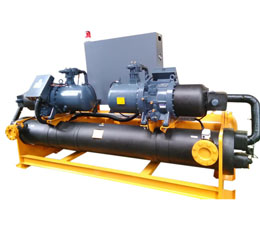- Home
- Products
- About Us
- News
- Project
- Video
- Soliutions/Oem/Custom
- Contact Us
Chillers are the largest single energy-using component in most facilities and can typically consume more than 50% of the electricity used. In North America and the USA, chillers use approximately 20% of the total electricity generated.
By design, most chillers achieve maximum tonnage with minimum kW usage by operating at approximately 70-75% of load and the lowest entering condensate temperature (ECWT). Understanding chiller efficiency and the impact of load and ECWT will help facilities determine the most efficient chiller configuration to maximise energy cost savings.
The first step in maximising chiller efficiency is to establish a method for recording chiller operating data in a daily log.
It is common for facilities to maintain chiller logs, but unfortunately, they are rarely reviewed, which is critical. Collecting and trending chiller operation data can be done automatically. Chiller performance at full and partial loads can be accurately measured, efficiencies calculated and the causes of inefficiencies diagnosed.
Once the state of the chiller has been determined (baseline), operational changes can be made to improve efficiency and the results measured.
Air Cooled Chiller
Ensuring accurate data can be difficult. The most common assumption of a facility is that the flow rate to the chiller is constant and always at the design condition. Unfortunately, this may not be the case for several reasons. Chiller systems are dynamic, ever-changing models that must adapt to their surroundings. They expand and contract on the basis of their original design.
They are subject to wear, tear and ageing. The best advice is not to assume anything until it has been proven by accurate, ongoing verification. The best way to provide accurate data, obtain specific results and minimise problems is to verify tonnage measurements and other calculations of flow to the chiller to determine efficiency.
Flow meters can be of the high quality turbine type, magnetometer (in-line) or ultrasonic (external) and provide the most accurate gallons per minute (GPM) flow readings.GPM can be determined by using the delta pressure of a pressure gauge or chronograph. Delta temperature does not actually measure the GPM flow rate, but it can identify proper flow rates and flow related problems.
It can also be affected by other conditions not directly related to flow, such as fouled cooler barrels, non-condensing gases and refrigerant levels, which can make operation more difficult. However, the use of a delta temperature together with a flow meter or delta pressure gauge creates a powerful diagnostic tool that can identify problems affecting the efficiency of a chiller system.

Water Cooled Chiller
Along with the appropriate flow rate, temperature sensors/gauges, pressure sensors/gauges, meters etc. are checked and calibrated regularly or when problems are identified.
However, due to design constraints, occupant comfort levels or real-time energy prices (sacrificing efficiency at one time to improve efficiency at another), it may not be possible to increase chilled water temperatures to save money. The wet bulb conditions of the cooling tower system are utilised to reduce the incoming condensate temperature of the chillers.
This may result in a reduction of 1°F for every 1°F of the chiller's full load design value.
It is important to note that part loads associated with chiller type (high or low pressure) and compressor motor style (constant or variable speed) will affect chiller performance. Consult the chiller manufacturer to determine the appropriate guidelines for input condenser water temperature.
If you want to know more about air-cooled chillers or water-cooled chillers, which one suits your needs, welcome to contact us today or visit our website.
Copyright © Water Cooled Chiller, Water Cooled Scroll Chiller Supplier China All Rights Reserved | Sitemap